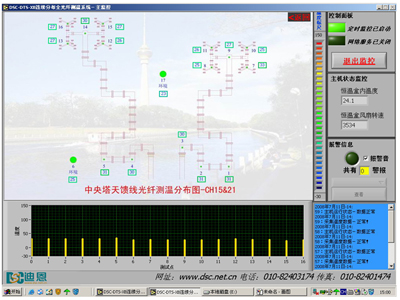Have you ever wondered how industries like oil and gas, power generation, and manufacturing can monitor temperatures in extreme conditions without direct contact? Enter fiber optic temperature measurement, a revolutionary technology that has transformed the way we gauge heat in challenging environments. In this extensive guide, we'll delve into the intricacies of fiber optic temperature measurement, exploring its benefits, applications, and the cutting-edge services offered by Beijing Deen Kangshuo Technology Development Co., Ltd.
Fiber optic temperature measurement is a non-contact method of measuring temperature using fiber optic cables. Unlike traditional temperature sensors that rely on direct contact with the object being measured, fiber optic sensors can detect temperature changes from a distance. This makes them ideal for applications where direct contact is impractical or dangerous, such as in high-temperature environments or where harsh chemicals are present.
Fiber optic temperature measurement works by utilizing the principle of the photoelectric effect. The fiber optic cable acts as a medium through which light travels. When the light encounters a change in temperature, it undergoes a corresponding change in intensity. This change is then detected by a photodetector, which converts the light signal into an electrical signal that can be measured and analyzed.
There are several advantages to using fiber optic temperature measurement technology:
Non-contact measurement: Eliminates the risk of damage to the object being measured and reduces the need for maintenance.
High accuracy: Fiber optic sensors can provide precise temperature readings, even in challenging environments.
Long-distance measurement: Fiber optic cables can be extended over long distances, allowing for temperature monitoring in remote locations.
Immune to electromagnetic interference: Fiber optic sensors are not affected by electromagnetic fields, making them suitable for use in electrically noisy environments.
Robustness: Fiber optic cables are durable and can withstand harsh conditions, such as high temperatures, chemicals, and radiation.
Fiber optic temperature measurement technology finds applications in a wide range of industries:
Oil and gas: Monitoring the temperature of pipelines and equipment to prevent overheating and ensure safety.
Power generation: Monitoring the temperature of turbines and generators to optimize performance and prevent damage.
Manufacturing: Monitoring the temperature of industrial processes to ensure quality and safety.
Automotive: Monitoring the temperature of engines and exhaust systems to improve performance and reduce emissions.
Medical: Monitoring the temperature of patients during surgery to ensure safety and comfort.
Beijing Deen Kangshuo Technology Development Co., Ltd. is a leading provider of fiber optic temperature measurement solutions. With years of experience in the industry, the company offers a comprehensive range of services, including:
Customized fiber optic temperature sensors: Designed to meet the specific needs of each application.
System integration: Integrating fiber optic temperature measurement systems with existing infrastructure.

Technical support: Providing ongoing assistance and maintenance to ensure optimal performance.
Training: Offering training programs to help customers understand and utilize fiber optic temperature measurement technology effectively.
Let's take a moment to compare fiber optic temperature measurement with traditional methods:
| Traditional Methods | Fiber Optic Temperature Measurement |
|---|---|
Direct contact with the object being measured |
Non-contact measurement |
Prone to damage and maintenance issues |
Robust and low maintenance |
Accuracy can be affected by environmental factors |
High accuracy and immunity to environmental factors |
Limited to short distances |
Long-distance measurement capabilities |
In the power generation industry, fiber optic temperature measurement plays a crucial role in ensuring the safety and efficiency of turbines and generators. Here's a brief case study to illustrate its benefits:
At a power plant, traditional temperature sensors were prone to failure due to the harsh operating conditions. By implementing fiber optic temperature measurement systems, the plant was able to:
Eliminate the risk of sensor failure
Obtain precise temperature readings
Monitor temperature changes in real-time
Improve overall plant efficiency
Fiber optic temperature measurement is a powerful tool that has revolutionized the way we monitor heat in challenging environments. With its numerous benefits and diverse applications, it's no wonder that this technology is becoming increasingly popular across various industries. By choosing a reliable provider like Beijing Deen Kangshuo Technology Development Co., Ltd., you can ensure that your temperature measurement needs are met with precision and efficiency.